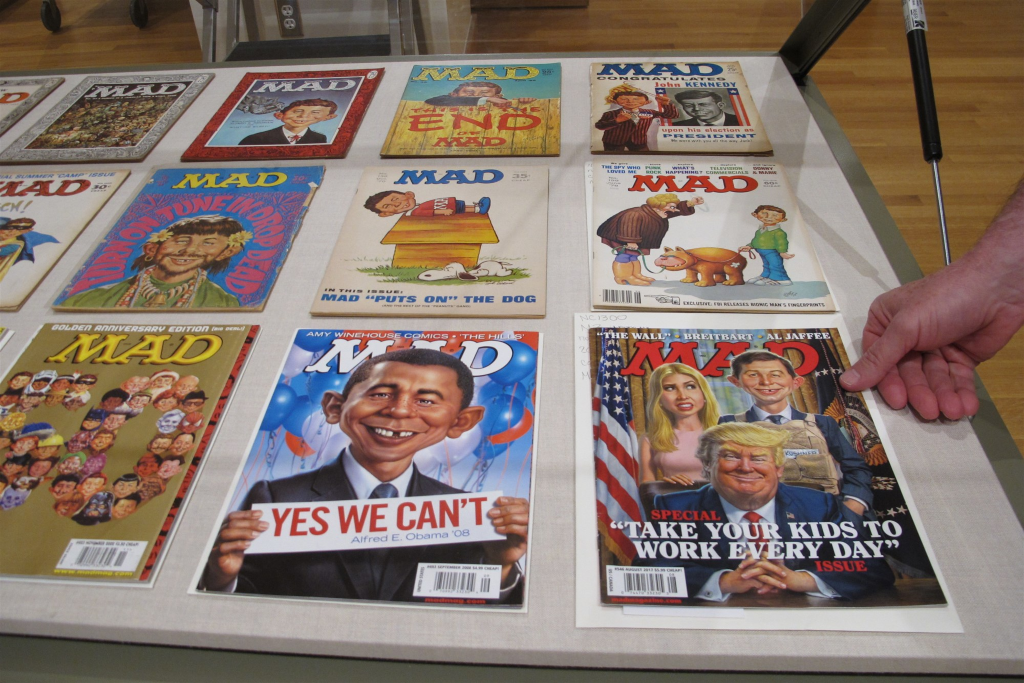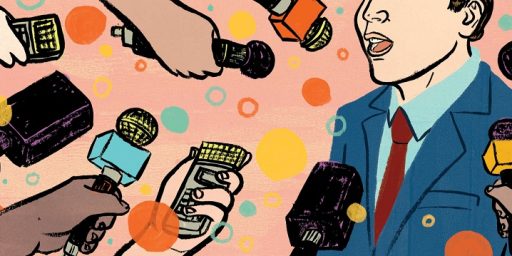Mad Magazine Basically Coming To An End
After 67 years, Mad magazine is ceasing publication of new material.

Marking the end of a history that stretches back nearly seven decades, Mad magazine, once the premier satirical magazine in the country, will largely cease publication and will no longer appear on newsstands:
Mad magazine, the satirical publication famous for asking, “What, me worry?” and its gap-toothed, big-eared mascot Alfred E. Neuman, is coming off newsstands and will largely stop publishing new content, its owner DC said an email Wednesday night.
DC said that after Issue 10, there will be no new content, except for end-of-year specials, which will be all new. Issue 8 of Mad magazine, which had been published every other month, went on sale June 12.
Starting with Issue 11, the magazine will feature best-of and other nostalgic content from its 67 years of publication, DC said. The magazine will still be sold in comic shops and mailed to subscribers.
DC did not explain the decision.
The magazine was founded in 1952 by editor Harvey Kurtzman and publisher William Gaines. It debuted as a comic book in 1952, then switched to magazine format three years later, the Associated Press has reported. Long-running comics and features include “Spy vs. Spy” and a back page that folded to reveal a hidden image.
Parody songwriter “Weird Al” Yankovic was among those lamenting the news on Twitter Wednesday night, saying he was “profoundly sad” to hear about the developments.
“I can’t begin to describe the impact it had on me as a young kid — it’s pretty much the reason I turned out weird. Goodbye to one of the all-time greatest American institutions,” Yankovic wrote, ending the message with the tribute #ThanksMAD.
DC said it will continue to publish Mad books and special collections.
The magazine has been called an influential force in satire and parody and has been referenced “The Simpsons” and other television shows and movies.
More from The Hollywood Reporter:
MAD Magazine, the irreverent and highly influential satirical magazine that gave the world Alfred E. Neuman, will effectively cease publication some time later this year after 67 years, The Hollywood Reporter has confirmed.
Sources tell THR that after issue 9, MAD will no longer be sold on newsstands and will only be available through comic book shops as well as mailed to subscribers. After issue 10, there will no longer be new content in subsequent issues save for the end-of-year specials (those will be all-new). Beginning with issue 11, the magazine will only feature previously published content — classic and best-of nostalgic fare — from its massive vault of the past 67 years. DC, however, will also continue to publish MAD books and special collections.
On Wednesday night, MAD cartoonists David DeGrand and Evan Dorkin took to social media to confirm and lament the closure of the magazine. The news follows writer Dan Telfer’s tweet earlier this week about being laid off as a senior editor at the magazine.
DC Entertainment, the publishers of MAD, declined to comment.
“Today won’t end. Goodbye, MAD Magazine. As a youngster I was a huge fan of the 70’s era, as a young adult I rediscovered the 50’s comics, as an old nerd I somehow became a contributor (often working w/@colorkitten) for the last decade +. Getting the e-mail today was crushing,” Dorkin said in a tweet thread, confirming his own departure and a staff-wide email about the closure. Dorkin ended his thread with “for all intents and purposes, MAD is folding.”
Responding to social media speculation that MAD was shuttering, DeGrand tweeted “can confirm.”
The venerable humor magazine was founded in 1952 by a group of editors led by Harvey Kurtzman. Although it began as a comic book, bimonthly issues were published and became the norm for the satirical content. MAD, with it’s always memorable covers featuring the gap-toothed Alfred E. Neuman, has been highly influential on successive generations of comedians, artists, writers and performers.
To be honest, I haven’t read Mad since I was a teenager and, indeed, had largely stopped reading it on a regular basis when I was still in High School in the mid-1980s. If you had asked me prior to this news, I would have been surprised that it was still in publication up until now. Part of the reason for that is because I had largely outgrown the stage of life where I thought the magazine’s content was really all that funny, many times it simply wasn’t unless you were, in fact, a teenager and most likely male (I may be wrong about this but I would guess that very few women or teenage girls read Mad on a regular basis.) The other reason was that, especially with the rise of the Internet and outlets such as The Onion, the standard for satire has become much higher than it was in the past. Combine that with the fact that newsstand sales and subscriptions had, according to other reports, slipped significantly over the years to the point where it no longer made fiscal sense to continue publishing a magazine that had obviously peaked years ago.
In any case, I’d say I will miss Mad magazine, but the honest truth is I haven’t really given it much thought since I was 13 or 14 years old. So, it appears, have many others.






Yeah, I read Mad and Cracked on a fairly regular basis a really long time ago. Maybe even as a pre-teen. I’d probably moved on by high school and haven’t given them much thought since.
I read my first issue in 1957. It had a deep impact on me and truly opened my mind. Yes, like others, puberty shifted my focus away, but the initial effect was lasting. It showed me that the society that valued jocks more than nerds can be laughed at. Potrezibie forever!
It turns out that my mother was a big fan of Mad, and she would often get one, read it, and then share it with me.
I still have a copy of the “Mad Poetry Round Robin” tucked away, and some of the poems I have memorized.
The illustrious computer scientist Donald Knuth proudly lists “The Potrezibie System of Weights and Measures” as his first publication.
But no, I haven’t looked at it lately, either.
Mad makes sense if you look at it in the light of the time when it was originally created–the same culture that had “Leave it to Beaver” as the “good” entertainment. Mad Magazine was kicking against the sticks, was what corresponded to The Lord of Misrule back in those Good Old Days…it grew, it peaked, and now it’s dead. Part of the problem was that it didn’t change all that much. The jokes were similar, if updated. It ended up like a fly trapped in amber–a perfect example of “comedy as it used to be”, which although potentially interesting to historians of U.S. culture, didn’t have sufficient attraction in the modern age to maintain a market. As it is, I suspect the main purchasers of “special issues” will be Baby Boomers nostalgic for the humour of their youth.
Might as well mourn about the demise of radio plays.
@grumpy realist:
There was a very old Simpsons’ episode (c. 1996) where Bart and Milhouse buy an issue of MAD. They mock it for being outdated even then, as Milhouse observes “they’re really socking it to that Spiro Agnew guy. He must work there or something.”
I liked their movie parodies, as they saved me the trouble of actually seeing some of those movies . Berg’s “The Lighter Side of” was only mildly funny, but had amazing artwork. I also liked Snappy Answers to Stupid questions by Al Jaffee.
@Kathy: Yes, the movie and tv parodies could be quite good.
@James Joyner:
Yea that’s why I estimate 13 or 14 when I was still in middle school, as the point where I probably last read Mad or Cracked. It was a perfect fit for what boys in their early teens think is funny and had allusions to sex that also speak to that audience.
The problem of Mad is that they relied on the same contributors and the same IP until the 90’s, and they never managed to find material that was good as their older material. They relied on Al Jaffee and Spy vs Spy until forever. But they have lots of interesting IP that could be used in other media, and it would not be that difficult to find stable readership for a humor magazine.
I think that does not bode well for the way that AT&T is managing Warner Media.
Yes.
Mad was good, National Lampoon was great. May they both rest in peace.
How soon will we morn the passing of SNL?
(P.S. Every old issue of Nat’l Lampoon is now online:http://www.nationallampoon.com/ )
I had a subscription to Mad from the ages of 11-14. Sometimes they were corny, but sometimes they were profound. One recurring feature was “You can never change a bigot.” It consisted of two-panel cartoons, the first with the header, “If a bigot says…,” and the second, after the bigot is proven wrong, “Then the bigot will also say…”
Two examples: in the first panel, a waiter tells a fellow waiter that he’s serving a table of Jewish people, “and they probably won’t even leave a tip, because they’re so cheap.” In the second panel, after they’ve left a generous tip, he says, “That’s because the Jews have all the money!”
In another, a woman sees a Latino family moving into her neighborhood and complains that they’re probably on welfare. When she learns that they’re working, she complains that they’re taking jobs away from Americans.
This feature was very well done, both because the bigot in the cartoons could be any gender or race, and because Mad recognized the persistence of bigotry at a time when many people assumed it would die out.
@Liberal Capitalist: Is SNL still on? I haven’t watched it since Eddie Murphy did “The Velveteen Jones School of Technology” skit.
In its heyday Mad reflected the worldview of largely secular, middle class Jewish people in the New York area, which described many of its creators.
I read it fairly regularly from about ages 10 to 14 but then lost interest.